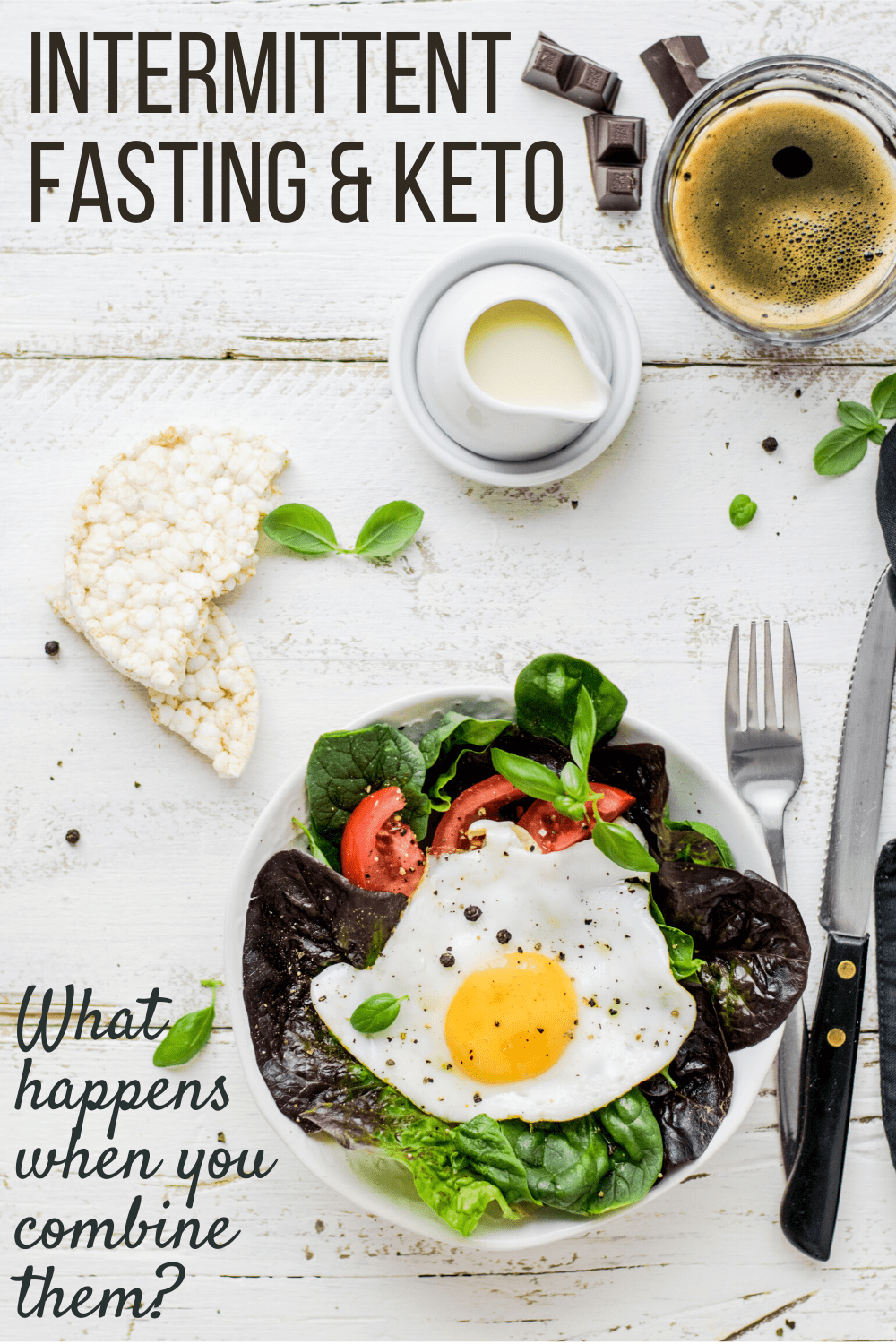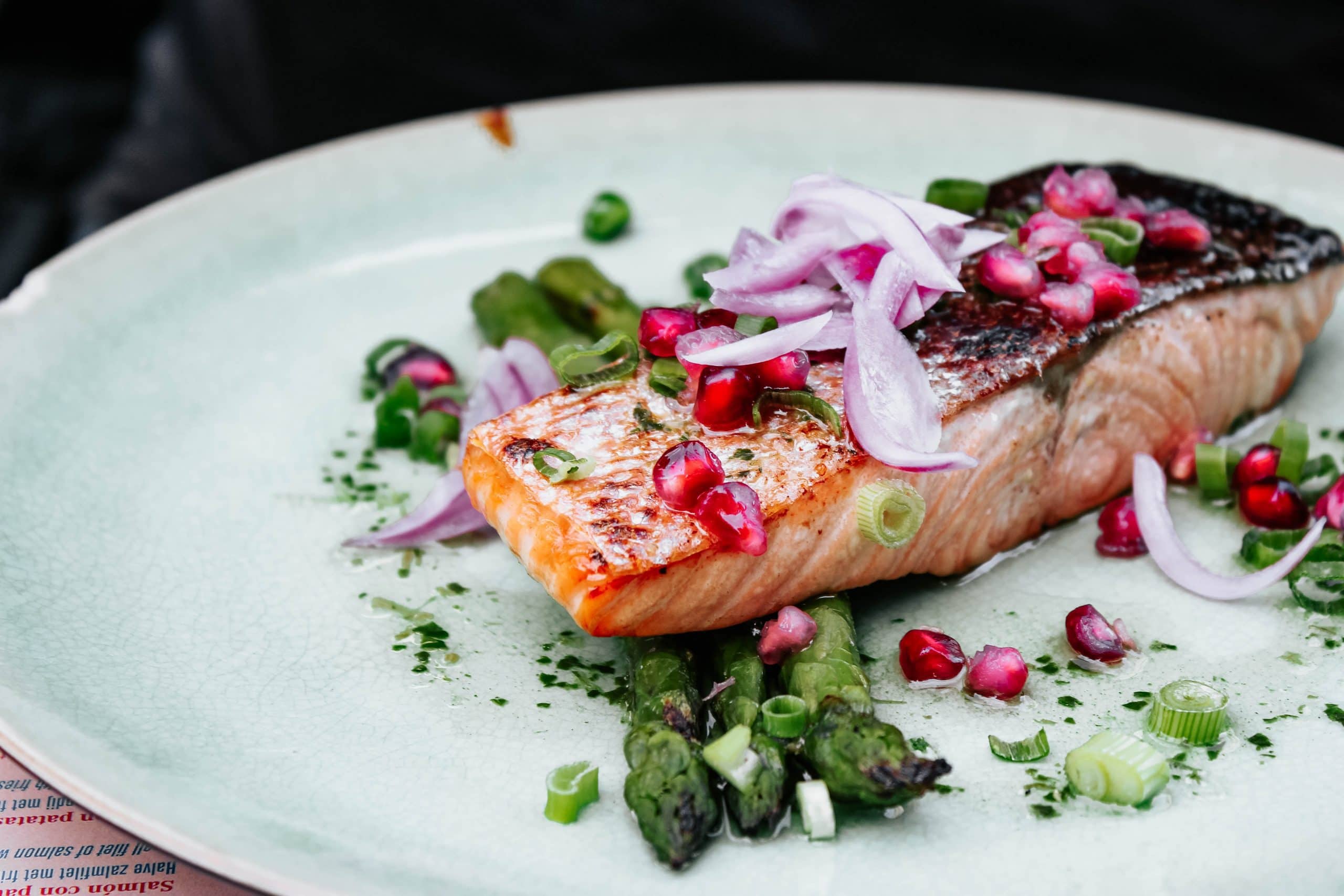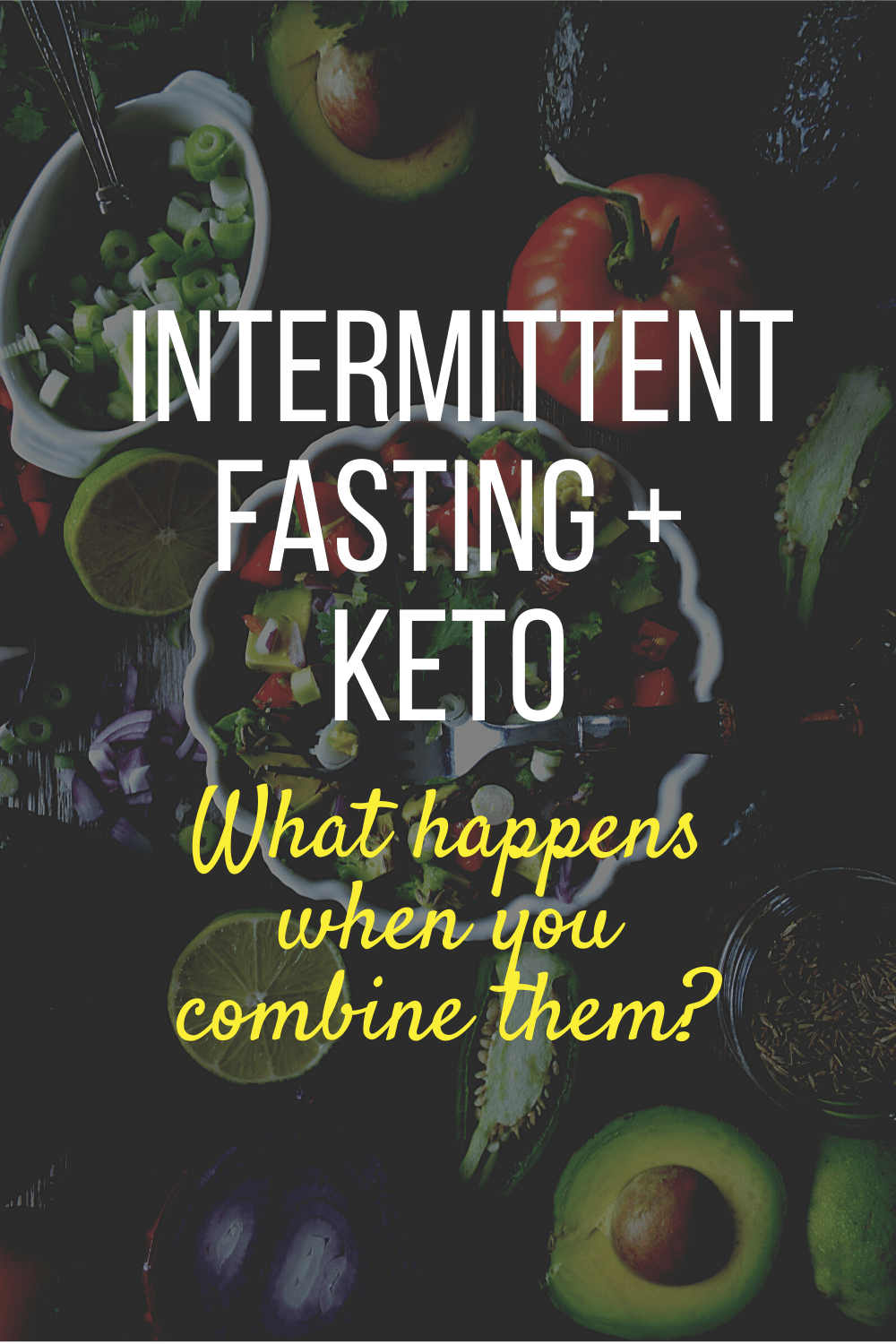This post may contain affiliate links. As an Amazon Associate I earn from qualifying purchases. If you click and buy, I may receive a small commission at no extra cost to you. Read our Disclosure Policy
We take a closer look at the benefits you might expect when you combine intermittent fasting and keto and whether it can help you to lose weight.

If there is one thing in life that seems to come around more often than busses its a new weight loss program or fitness craze.
Over the past few years the Keto diet (also known as the low carb diet) has been hugely popular and now the new buzzword seems to be Intermittent Fasting.
At first glance these two methods might look like pretty much the same thing, but they are very different and work in different ways.
The interesting thing about these two weight loss regimes is that they can be combined and apparently they can help you achieve better results when you do.
So today we’re digging a little deeper to find out what happens when you combine intermittent fasting and keto.
As with any major lifestyle change, it’s advisable to speak to your healthcare provider before trying either of these methods.
What is Intermittent Fasting

You need to understand the difference between the keto diet and intermittent fasting before you get into the benefits of combining the two methods to accomplish weight loss.
The first is intermittent fasting, which is not a diet in itself, but a pattern of eating.
It tells you how many hours during the day you will fast, which means you are not consuming anything with calories or sugar, then the number of hours you will have your “Eating window”.
For example, a popular protocol is 16:8, which means you fast for 16 hours, then eat over an 8-hour time period.
The fasting includes the hours you are sleeping, which can make this much easier to do.
You either skip breakfast or dinner, meaning your day’s meals are probably consisting of 2 meals a day, with another optional snack.
Why Intermittent Fasting
Intermittent fasting comes with a lot of different health benefits, including:
- Helping you to burn fat and lose weight effectively
- Balancing your hormone levels
- Reducing insulin spikes
- Helping with your digestion
- Giving you more natural boosts of energy
- Less brain fog
Different people report different health benefits from fasting, but this is a great place to start.
Other Intermittent Fasting Protocols
You can also choose from many other protocols, depending on your schedule and preferences. Here are some other options that might interest you:
20:4/Warrior Diet – Known as the Warrior Diet, the 20:4 protocol has you fast for 20 hours, and then eat over a 4-hour period. With this protocol, you might eat one large meal and a snack, or 2 moderately-sized meals. This is good for people who want to get the most from fasting, or who prefer less meals that are of a slightly larger size.
OMAD – To push it even further, you can do OMAD, or one meal a day. It is just what it sounds like. You are going to eat just one meal a day, often a considerably large meal in order to get the nutrients and calroies you need for the entire day. Most people enjoy their meal over about a 1-hour period, then fast for 23 hours.
Alternate Day Fasting – Some people like to occasionally do extended fasts, where they will go 24 hours or longer while fasting, then have a day of eating within their normal diet or calories. This is something you should work up to instead of shocking your system with on day one, but you can often see a lot more benefits if you decide to give it a shot.
You can find out more in our Guide to Intermittent Fasting.
What is the Keto Diet

The ketogenic diet comprises of a low-carbohydrate or high-fat diet that helps in controlling body weight.
This diet allows your body to enter into the nutritional ketosis mode, which means that your body burns excess fat to get the needed energy requirements due to a shortage of glucose.
With intermittent fasting, you get into ketosis, but not for as long as you do when following the keto guidelines.
Once you enter your eating window, your body is going to be knocked out of ketosis.
When you are following the keto diet though you stay in ketosis.
Basic Rules of Keto
With the keto diet, you need to eat extremely low amounts of carbs, usually under 20 net carbs, though some people can eat up to 50 net carbs and still remain in ketosis.
The net carbs are going to be the amount of carbs minus fiber, since fiber absorbs differently.
This can take some getting used to, but here are some foods that are low in carbohydrates, that many people eat while on the keto diet:
- Eggs
- Meat, Poultry, and Fish
- Cheese and Some Dairy
- Nuts and Nut Butters
- Oils, Dressings, and Condiments
- Low-Carb Veggies
Some of those low-carb veggies include tomatoes, avocado, cucumber, zucchini, olives, all types of leafy greens and lettuce, bell peppers, mushrooms, onion, and many others.
The healthy fats are also really important because they help to satiate you and keep you full when you are doing the keto diet.
These include different types of oils, avocado, butter, and nut butters.
If you want to see what kind of meals you could eat check out our collection of beginner friendly Keto Meal Prep Ideas.
What You Don’t Eat on Keto
As you might expect, you no longer eat high starch vegetables, whole grains, or bread products.
This means no more English muffins, sandwich bread, baked goods like cakes or muffins, rice and grains, potatoes, oatmeal, and other similar foods.
High starch vegetables and high sugar fruits like sweet potato, carrots, apples, bananas, peaches, pears, corn, peas, and others will also not be consumed while on the keto diet.
Benefits of Keto
In addition to fat burning and weight loss, you get many similar benefits to keto that you do with intermittent fasting. Some things you might experience include:
- More energy
- Less brain fog
- Less bloating
- Improved digestion
- Reduced appetite
- Reduced cravings
Think about how you feel after high carb meals, like being lethargic and having bloating, and you can imagine how you would benefit by not having those sensations.
Another big benefit people experience with keto is no more inflammation.
If you suffer from chronic pain from conditions like arthritis, this can be a huge deal for you.
Some people with Crohn’s and other inflammatory diseases also find a lot of benefits from switching to this type of diet.
Why Combine Intermittent Fasting and Keto

The main reason why people like to combine intermittent fasting and keto is because it makes both more effective.
Intermittent fasting is going to get you into a state of ketosis, but only when you are fasting over long stretches.
With the keto diet, you remain in ketosis unless you eat over the recommended of carbs per day, helping the fasting to be more effective.
In essence, keto helps make fasting more effective, and fasting helps make keto more effective.
Sounds awesome, right
This is why so many people tend to do intermittent fasting with keto, and vice versa.
Benefits of Combining Them
Burning More Fat – It would help if you carried out a thorough research on how you can incorporate a keto diet with intermittent fasting to achieve desired weight loss. If you are looking to gain muscle weight, you can comfortably use keto and the IF method.
This is generally because; even though the ketogenic diet restricts the increase in muscle mass, intermittent fasting will help increase growth hormone production and blood glucose regulation and improve your body’s sensitivity to insulin. When you use intermittent fasting with the keto diet, you generally speed up the process of ketosis.
Less Hunger While Fasting – When your body is in full ketosis mode, you will find it quite easy to stick to fasting without fail because the hunger pangs will not affect you that much. The intermittent fasting method will increase the metabolism rate in your body, and this will help you cope better when you reduce carbohydrate intake.
Also, when you are in ketosis and are partaking in intermittent fasting, your body tends to use the extra body fat as a source of energy, which lowers the body fat percentage end, gives you a leaner figure.
Tips for Combining Keto with IF

If you decide you want to get the benefits from both keto and intermittent fasting, here are a few tips that are going to help you along the way.
Start with One or the Other
While many people do these together at the same time in the beginning, it can be a little overwhelming. You are switching to a brand new diet as well as trying to track the hours you eat or don’t. This might prove to be a little difficult.
A better option is to start with either fasting or keto, do it for a couple weeks, then add the other one.
Which to start with This is up to you, but if you are concerned about your hunger, starting with keto is probably going to be a little easier. This is because once you get into a state of ketosis with the keto diet, your hunger and appetite lessen, which would make it easier to fast when you add in your intermittent fasting.
Become Familiar with the Keto Diet
Keto is easy once you get the hang of it, but it can be quite the job in the beginning. It is a much different way of eating for most people, so you want to learn as much as you can before you even start your first day.
With keto, you are going to stick to 20 and 50 net carbs a day, which means no bread, pasta, rice, potatoes, starchy vegetables, or baked goods .There are keto versions of many of these foods, but when first starting out, you don’t want to bother with that.
Try to keep it simple by just having meals with your protein and vegetable, and fats added in. For example, breakfast might be eggs with bacon and avocado, ro some people like to do an egg scramble with eggs, cheese, meat, and veggies.
Lunch can be a protein and vegetable, whether you go with a big salad that uses grilled chicken, low-carb veggies, and an appropriate salad dressing. Others like to do steak and veggies, shrimp sautéed in butter with asparagus, or any other combination you enjoy.
Dinner can be similar to lunch, or you can have your eggs at dinnertime. There are a lot of options, once you understand the basics of what you can eat.
Track How You Feel
Tracking during your intermittent fasting and keto journey can also be really helpful. Track what you eat and how much, your carbs to be sure you are in keto, and the hours you are fasting.
This is important for many reasons. First of all, you ensure you are abiding by all the rules of both keto and fasting. It also helps you to see how you are reacting to both of them. If you hit a plateau, lose energy and focus, or have more positive effects, you will know about it if you are tracking.
Using digital apps like Zero make it a lot easier to track the hours you fast, since you just push a button when fasting, then again when your eating window starts.
You can also use a digital planner or journal, a physical journal with a pen, or any number of apps. Choose the option that works best for you and is something you will stick with.
If Weight Loss is Your Goal
You are already going to be burning more fat when you do both the keto diet and intermittent fasting, but here are a few more things to keep in mind if weight loss is your main goal:
Count Your Calories – A calorie deficit is still part of losing weight, so even if you are combining keto with IF, you do still want to pay attention to your calories. They should not go too low, but you want to make sure you are burning more than you are consuming. Aim for a deficit of about 500-1,000 a day in order to lose weight at a moderate pace.
Start Exercising – This is optional, but it can help you burn more calories during the day, which actually allows you to eat more! Choose your favorite form of exercise, whether that is strength training, resistance training, yoga, Tai Chi, walking or running, swimming, or any other form of activity. For best results, combine strength training with cardio exercises.
Focus on Protein – While keto is considered a moderate protein diet, it is still important for satiety reasons, energy, and weight loss. Make sure you are getting an adequate amount of protein a day, with sources like meat, fish, chicken, eggs, cheese, and nuts. These foods allow you to have a good amount of protein, but will still help you stay within your keto diet.
What You Should Know Before You Start

Most healthy individuals will comfortably use the ketogenic diet and intermittent fasting together without any adverse effects.
However, it is not a good weight-loss plan for either pregnant and breastfeeding women.
Also, if you have a history of disordered eating, you should avoid using these weight-loss diets.
If you are under medication for any life-threatening condition such as heart disease and diabetes, it is always good to consult with your doctor before using either of the two methods or combining them.
It is still important to note that these two weight-loss regimes are not user-friendly to everybody.
You might find that intermittent fasting while on keto is not working for you, or instead of sticking to a healthy meal plan after breaking your fast, you tend to overeat and ruin the purpose of the meal plan.
Other adverse effects you might experience include irritability and fatigue.
It would be best if you tried combining the two methods, and find out whether they work well with your body.
Hopefully, they will work well together and bring in the intended results, such as helping to increase ketosis by reducing the level of insulin.
It would help if you also looked out for other added benefits such as the decrease in body fat, and a reduced appetite.
However, you should not feel like a failure when the combination does not work for you.
It is best to note that people are different, and what works for one person should not necessarily work for another.
If you sense an adverse change in your body while combining the keto diet and intermittent fasting, it is best to look for a better alternative.
Important Note About Disordered Eating Habits
Because both intermittent fasting and keto are restrictive ways of eating, it is not recommended to people with a history of eating disorders or disordered eating, unless under doctor supervision.
Not only are you only allowed to eat during certain hours of the day, but keto has a lot of dietary restrictions.
Many people find this to be beneficial for their physical health, but if you struggle with an obsession over food and restrictions, it might not be the best idea for you.







